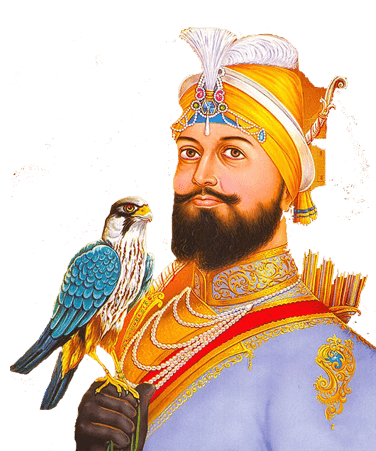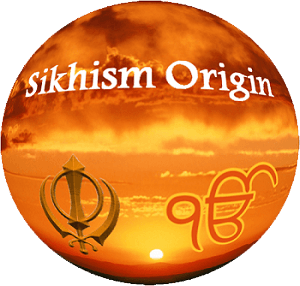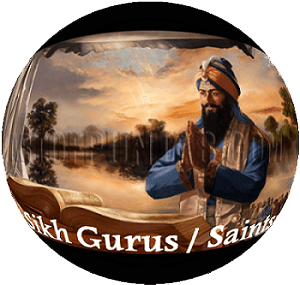Tenth Master - Guru Gobind Singh (1666-1708, Guru ship 1675-1708)

| Guru Gobind Singh | Details |
|---|---|
| Father | Guru Tegh Bahadur Ji |
| Mother | Gujri Ji |
| Date of Birth | 12/22/1666 |
| Place of Birth | Patna Sahib |
| Wife | Mata Sundari Ji |
| Children | Ajit Singh, Jujhar Singh, Jorawar Singh & Fateh Singh |
| Age, Year & Time At Gur Gadhi |
11/11/1675, 33 Year |
| Regimes | Aurangjeb, Bahadur Shah |
| Contribution of Banies | Jap Sahib, Akal Ustat, Chopai, War Shri Bhagoti, Vachitar Natak, Chobis Avtar Chandi, Charitar, Shastar Nam Mala (Dasam Granth) |
| Age | 42 |
| Jyoti Jot Day | 10/07/1708 |
| Jyoti Jot Place | Nanded |
' I establish thee as my son, that you spread My Path. Go and instruct men in Righteousness and the Moral Law, and make people desist from evil.' I stood up, with joined palms, and bowing my head to Lord God, I said: Thy Path I shall spread only if Thou be at my back.
For this was I born into the world, I utter only how and what God uttered to me, for I am the enemy of no one. He who calls me God will surely burn in the fire of hell. For I am only the servant of God: doubt not the veracity of this statement. I am but the slave of the Supreme Being come to witness His Play. I tell the world only what my God said to me, for I will not be silenced through fear of the mere mortals. I utter as is the Instruction of my God, for I consider no one greater than Him. I am pleased not with any religious garb, so I shall sow the seeds of the Unaccountable One. Nay, I worship not stones, nor am I attracted by denomintional coats. I utter only the name of the Infinite and so attain unto the Supreme Being. I wear not matted hair, nor ear-rings, nor have regard for any such ritual, and do only what God bids me do. I repeat only the Name of One God who fulfills us, at all places. No, I utter not another's name, nor establish another God. I dwell upon the Name of the Infinite One and so realise the essence of the Supreme Light. I give thought to none else, nor utter another's name. O God, with Thy one Name I am imbued. I have no other pride. Yea, I utter only Thy Name and eradicate my endless sins. (Guru Gobind Singh, Vachitra Natak)
Upon the death of his father, Guru Gobind Singh felt compelled to organize the Sikhs into a community of saint-soldiers. During the spring of 1699, the Guru called his followers for a special gathering. During the day, thousands of people assembled in front of a stage and a tent, out of which emerged the Guru to address the massive audience. With sword in hand, the Guru asked the congregation if anyone would be willing to sacrifice their head for him. Naturally, the audience was stunned by the Guru's request, and many followers began to disperse out of sheer terror. Still, the Guru pressed for one of his followers to give their life for him. Finally, one of the assembled stood, with hands folded, and approached the Guru in full submission. The lone disciple was led into the tent by the Guru.
After some time, the Guru emerged with a blood-stained sword and asked for another head. Overcome with shock, the audience could not believe what they were seeing; however, another devoted follower stood and offered his head to the Guru. Eventually, with the same outcome, three more devoted disciples offered their lives to the Guru. After the fifth devotee was led into the tent, to the surprise of the massive audience, the Guru emerged with the five followers fully clothed in the uniform of the Khalsa, or Pure. The Guru's demonstration symbolized a revitalization of the Sikh identity and the definitive evolution of the Sikh community into a community of saint-soldiers. After initiating the five "beloved ones" into the new order of the Khalsa, the Guru knelt before them and requested that they initiate him. In the annals of human history, such a transformation into a distinct and solidified community, culminating in the baptism of the prophet by his followers, remains a unique and defining moment. Guru Gobind Singh and his Khalsa army were engaged in several battles against the imperialist Mughal army during the Guru's life. Through the course of those turbulent times, the Guru lost his four children and his mother to the cause of righteousness; but nevertheless, the Khalsa stood firm as a distinct and sovereign entity, able to withstand the onslaught of a mighty enemy.
In the face of persecution, the Guru wrote: When all peaceful means of resolution have failed, it is righteous to draw the sword. Before his death at the hands of an assailant in 1708, the Guru added the writings of Guru Tegh Bahadur to the Sikh scriptures, thereby giving a final revision to its form. The Guru also declared the lineage of living Gurus finished, and requested his followers to seek spiritual guidance from the Guru Granth Sahib. In essence, the light of Nanak, the first Guru, was to be forever enshrined within the pages of the Guru Granth Sahib.
To illustrate his point that the Guru Granth Sahib was the final Guru of the Sikhs, and as a sign of humility, Guru Gobind Singh did not include his writings, over 1400 pages worth of literature, in the Guru Granth Sahib. A separate volume, called Dasam Granth, features the writings of the tenth Sikh Guru.







